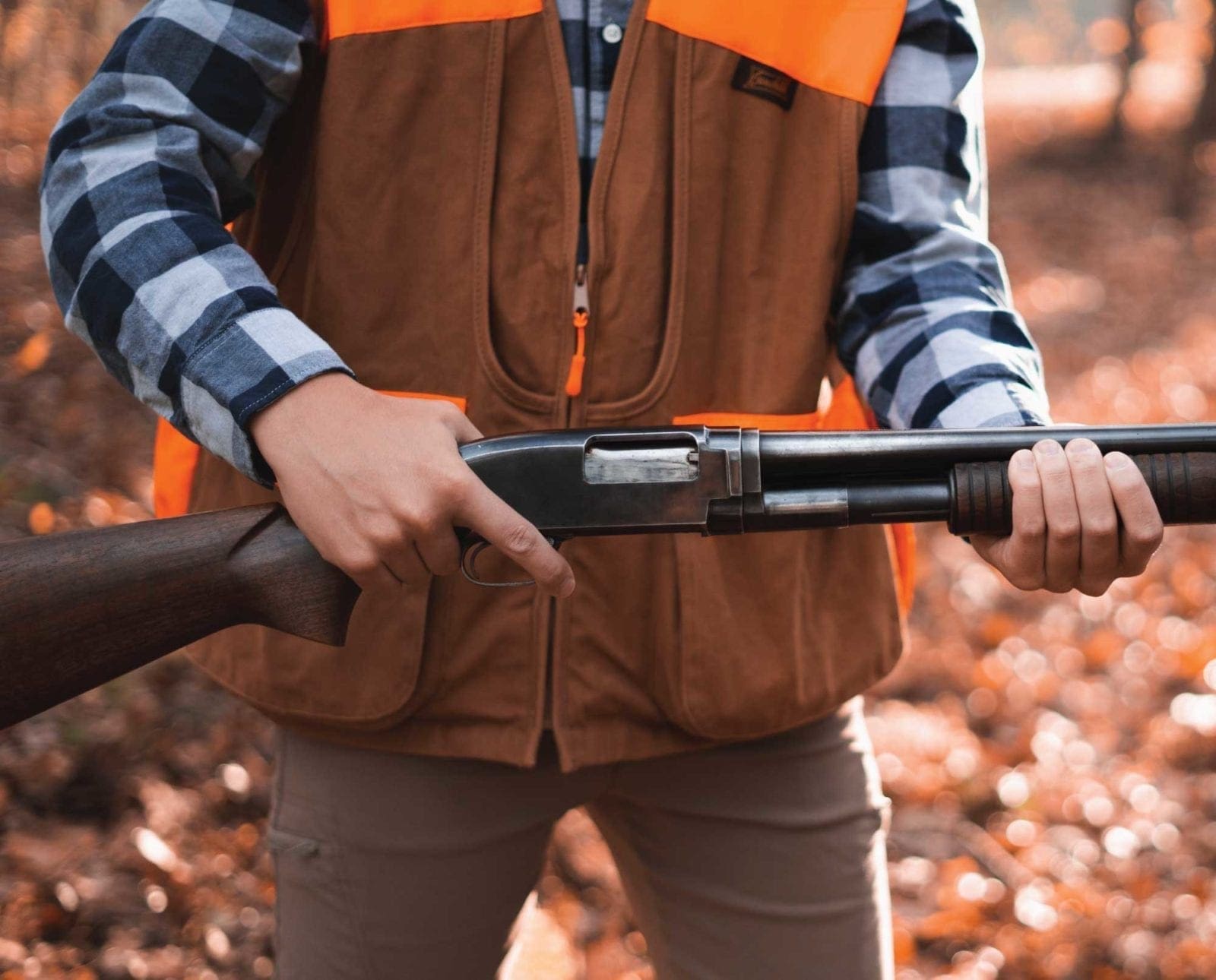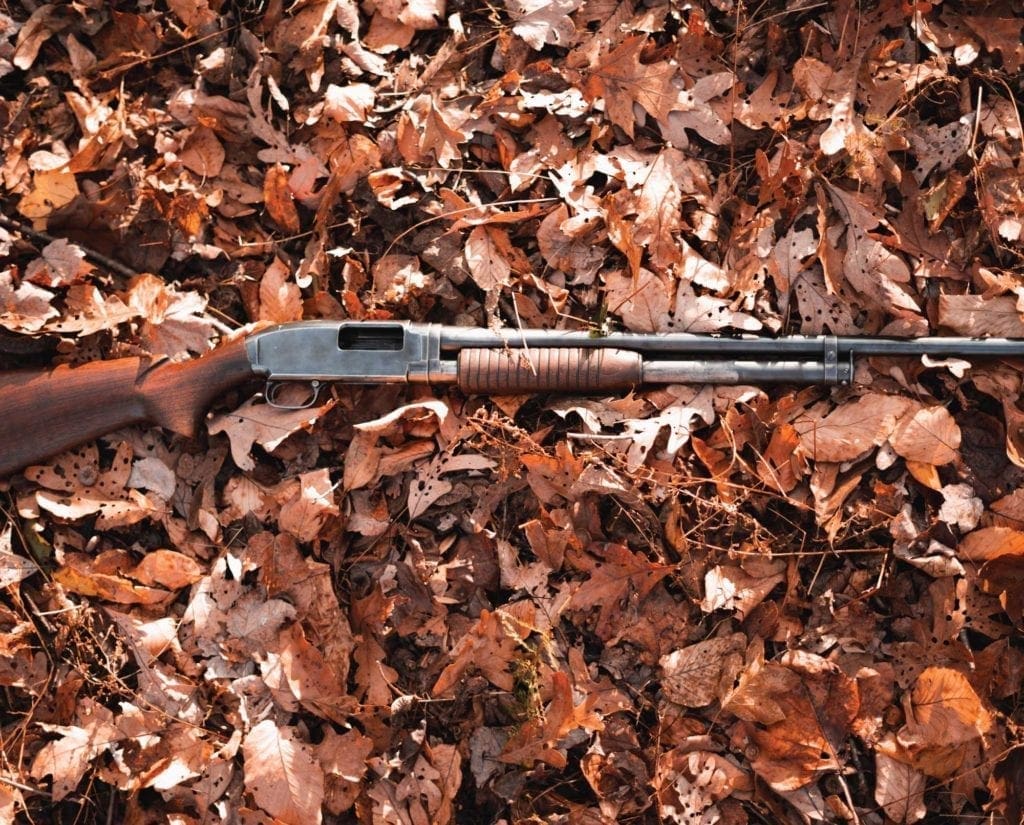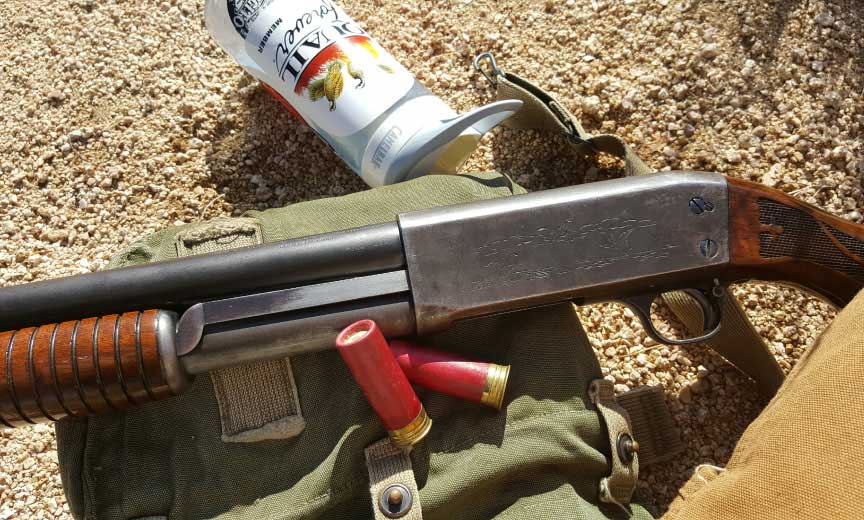Home » Firearms and Shooting » Shotguns » Exploring Vintage American Pump Shotguns
Exploring Vintage American Pump Shotguns

Jorge Ramirez is a writer, artist, and upland hunter who…
Exploring the vintage shotgun market of the American classic pump shotgun
The Damascus twist-barrels glistened grey and brown in the late morning autumn sun. I clutched the cold-vintage steel and wood in my clammy hands. The heft. The smell. This wasn’t a dream–it was mine. Finally.
I dreamed of owning a vintage double-barreled shotgun since I was kid. Not one of those over/unders, but a classical side-by-side. I don’t know where the fascination started, really. Old cowboy flicks where hammered coach-guns were backing up the hero in the final duel? Action movies from the 80s and 90s where the greased-up muscle dude had a sawed-off double? Maybe that pile of old hunting magazines my dad had in the garage with articles about old doubles. Or perhaps it was those vintage ammo-tin ads up at the old gun shops–the ones with the quintessential upland hunting scene! Y’know? The ones with the plaid-clad gentleman, steady behind his pointing-dog, pheasant bursting from the tall grass. Side-by-side aimed and ready. That did it for me . . . and a whole lot of other people too, I imagine.
As soon as I decided I was going to hunt birds, I knew I had to get an old double-gun. No ifs, buts, or doubts. I was going to buy the first affordable side-by-side I found. I had a goal in mind, and it had just become a reality. Never mind that my first shotgun was a piece of junk! My first double-gun was an old Hopkins & Allen 12-gauge side-by-side with 2-1/2 inch chambers and slightly bulged right barrel. I shot my first few upland birds with that hunk of junk. That gunshow find was the first of an ongoing love affair with side-by-sides (and a couple of over/unders).
After eventually getting rid of the Hopkins & Allen, I elevated my tastes in shotguns to better quality vintage American side-by-sides like Lefever and Ithaca, as well as an Italian-made over/under Beretta. I would never sully one of my upland hunts with anything but a double gun. I was part of a nostalgic group of hunters who felt the same way.
Not much has changed today. Take a gander at any upland hunting related social media account, and you’ll quickly notice that most of the top influencers all run a double. Every upland hunting magazine seemingly has a double gun emblazoned on every other page. Upland hunters have a firm foot in tradition, and tradition apparently is a double gun. At least that is what everyone is telling you. And that has perpetuated something of an elitist attitude towards other shotgun configurations.
Unbeknownst to many, alongside double guns the pump-gun and the semi-auto also have a lengthy tradition in the uplands. But the pump-action shotguns are what intrigue me the most. They were common among “working class” folk, whose no-nonsense approach and practicality made the pump a match made in heaven. They just keep on shooting, racking shell after shell, dropping bird after bird.
Their simplicity and reliability having been proven in the field, many upland hunters of yore swore by the pump-action shotgun. Yet they remain overshadowed by doubles in the upland hunting community. Am I bold to say that I find the Model 12 and Ithaca 37 sleek and elegant guns, rivaling even many double guns that are so coveted? With unique designs that were ahead of their time and inspired later well-known models like the Remington 870, classic pumps are worth the effort of collecting and taking out to the field.
Here are just a handful classic American pump-action guns that are worth picking up.
Winchester 1897
The Winchester 1897 is what I consider the first “perfected” pump-gun. The Model 1897 was the improved design of John Browning’s Model 1893. It improved upon several features of the Model 1893, including strengthening the receiver, which enabled it to utilize smokeless 2-3/4 inch shells. Available in either 16- or 12-gauge, this external hammered shotgun became the standard that all other pump-guns would be measured against. These guns are popular among the SASS (Single Action Shooters Society) crowd and come in several variants, such as the common Field Grade, the fancy Pigeon Grade or the legendary WWI issued “Trench” version.
The Model 1897 was manufactured until 1957 and with well over one million Model 1897s in circulation, they can be picked up for a reasonable price.
Winchester Model 12
When you hear the phrase “classic pump-action shotgun,” more than likely the gun that comes to mind is the Model 12. The internal hammered Winchester Model 12 evolved from the Model 1897 and soon became one of the most successful shotguns of its time. In every cornfield and duck blind, a Model 12 could be found! The Model 12 came in 12-, 16-, and 20-gauge. The rare 28-gauge version is a sought-after collector gun, so if your grandpa has one of these, get on his good side! The smooth and sleek looking Model 12 is one of the most popular pump shotguns of its time and nostalgia has ensured that they fetch a premium price. You can expect to pick up a well-used field grade in 12-gauge for around $300, while pristine examples, sub-gauge and “graded” variants can fetch several thousand dollars.

The Model 12 ceased mass-production in 1964. The milled receiver on the Model 12 was not cost effective in a market where the economical and reliable Remington 870 was king. There are about 2 million Model 12s that were produced, and that’s good news for someone looking to get into a Classic American Pump-Gun.
Remington Model 31
Remington produced the first bottom-ejector shotgun with Remington Model 10 but a later side-ejector, the Remington Model 31 makes my list for a couple of reasons. First, it directly competed with the beloved Winchester Model 12 and did fairly well in its short run (1931-1949). Second, it was the inspiration for some of the most popular shotguns on the market today–the Remington 870 and the Mossberg 500. The Model 31 had a buttery smooth “ball bearing” action that rivaled any of the pump guns mentioned here.
Available in 12-gauge as well as the rarer 16- and 20-gauge, the Model 31 was well received but could not beat the popularity of the Model 12, despite its smoother action, and was ultimately discontinued. Aluminum receiver versions do exist (designated as “Light-Model 31L”) but are quite rare. The Model 31 is the underdog on this list but holds up well against the more popular models. There were not as many Model 31s produced (less than 200,000) but due to it being overshadowed by guns like the Winchester Model 12, they can typically be picked up for a reasonable price.
Ithaca Model 37
The Ithaca Model 37 holds the record for the longest produced pump shotgun in America. Based on the often overlooked John Browning designed Remington Model 17, Ithaca made several improvements to Browning’s design. Marketed as a direct competitor to the widely popular Winchester Model 12, the Ithaca Model 37 saw production in 1937 after some delays. The Model 37 did not quite reach its popularity until well after WWII, however. Taking advantage of Browning’s unique design, the Model 37 utilizes a bottom port for loading and ejecting shells. This makes the Model 37 a great choice for left-handed shooters, as empty hulls are ejected towards the feet of the shooter, instead of across the face. This design also keeps the elements out of the Model 37’s action.

There are over 2 million Ithaca Model 37s in existence–and counting! It is the only pre-WWII shotgun still being manufactured today. The Model 37 was originally offered in 12-, 16-, and 20-gauge and a true-frame 28-gauge is currently available. Well-loved field guns can be had for a couple hundred dollars, while those in exceptional condition, anything under 12 gauge, and high-grade examples can fetch higher prices and up to a couple thousand dollars in the used-gun market.
Final thoughts on vintage pump guns
What else can I say? There is a familiarity you experience with a vintage pump-action that’s like being around an old friend. It just feels right. Your dad and your grandpa probably carried one of these! And I find that makes these guns something I can relate to.
To say the least, I gave up some of my closet space for a classic-pump-gun. Today, I find myself carrying my old pump into quail country more than any other gun I own. It’s a simple design. It gets the job done. But it’s still classy enough for the discerning upland hunter. A vintage pump-gun is built like a tank. I have yet to have any major issues with my Ithaca Model 37 that I could not repair myself. I cannot say the same for some of the classic doubles I’ve owned.
Dependable. Consistent. And who really minds that extra third shell? Sure. Scoff. Turn up your nose. They may not be for everyone, but their heritage cannot be denied. All I ask is that you give ‘em a second look and a second chance. Take an old friend hunting, why don’t you?
Jorge Ramirez is a writer, artist, and upland hunter who was born and raised in Southern California. His passion for upland hunting led to the creation of his blog/website, UplandJitsu: The Art of Upland Hunting. His blog primarily consists of articles dedicated to the traditions of quail hunting with an emphasis on introducing new hunters to DIY public land hunts, without a dog. He currently resides in Long Beach and hunts in the nearby National Forests for upland game.




Where’s the Remington Model 10?
Can any be used with steel shot? California hunting….
Don’t forget the Model 42 in 410 Ga.
Beware of newer Ithaca model 37 Featherweight pump shotguns. They have a defect in their design resulting in feeding issues. Both myself and my son bought brand new (in box) model 37’s. A 2011 16 ga. and a 2016 12 ga.
Both shotguns , after a shell is fired and the bolt is opened, a new round pops out on top of the rail guides then, as the rail guides lift the new round up toward the chamber, a second shell pops out of the magazine below the rail guides preventing the bolt from closing. One has to force the second shell back into the magazine in order to close the bolt. The 16 gauge was sent back to the factory twice. First time without any improvement or explaination. The second time without clear explaination and without significant improvement.
Model 37’s are fantastic. I have a Mod. 37 in 16ga. and a 1948 year in 12ga.